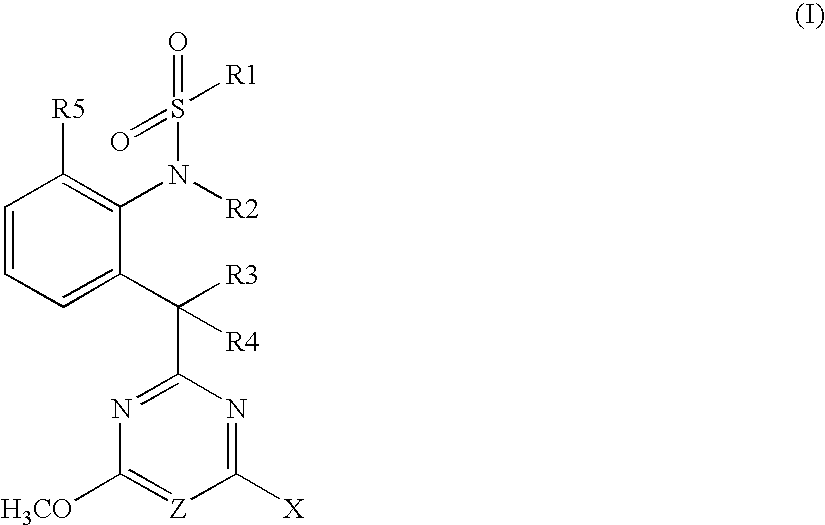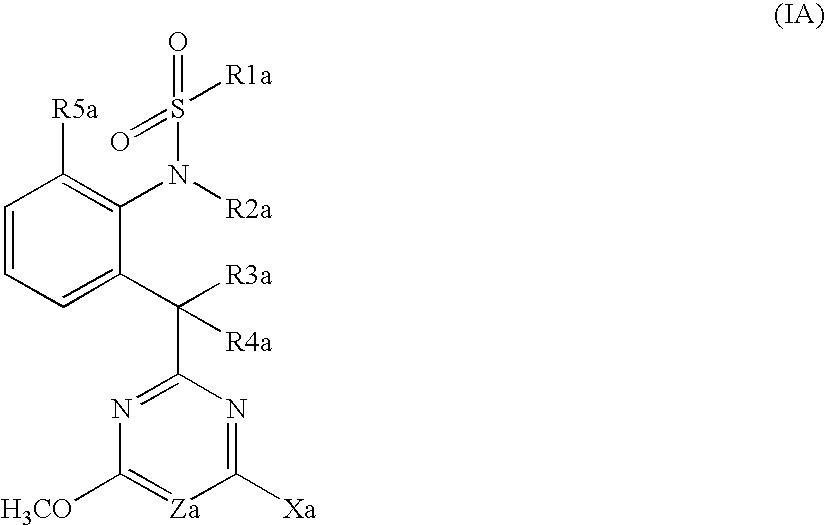Use of sulfonanilide compounds as herbicide
a technology of sulfonanilide compounds and herbicides, which is applied in the field of herbicide use of sulfonanilide compounds, to achieve the effect of convenient preparation
- Summary
- Abstract
- Description
- Claims
- Application Information
AI Technical Summary
Benefits of technology
Problems solved by technology
Method used
Image
Examples
synthesis example 1
[0263]
[0264]0.45 g of 2-bromo-6-[(4,6-dimethoxypyrimidin-2-yl)(methylthio)methyl]aniline (1.22 mmol) was dissolved in dichloromethane (3 ml) and 0.08 g of pyridine (0.97 mmol) was added to the resultant solution, and the resulting solution was cooled to −5° C. 0.18 g of 2,2,2-trifluoroethanesulfonyl chloride (0.97 mmol) was added to the solution. The resulting reaction mixture was stirred for two days at room temperature, water was added to the mixture, and the product was extracted with dichloromethane three times. The organic layer was washed with water and dried. Dichloromethane was evaporated to give an oily residue. The residue was purified by column chromatography to give 0.36 g of desired product, 2-bromo-6-[(4,6-dimethoxypyrimidin-2-yl)methylthiomethyl]-N-2,2,2-trifluoroethanesulfonanilide (yield: 57%).
[0265]1H NMR (CDCl3, 300 MHz) δ 2.04 (3H, s), 3.94 (6H, s), 4.08-4.29 (1H, m), 4.61-4.75 (1H, m), 5.81 (1H, s), 5.90 (1H, s), 7.24 (1H, t), 7.56 (1H, dd), 8.06 (1H, dd), 9.16 ...
synthesis example 2
[0266]
[0267]1.00 g of 2-iodo-6-[(4,6-dimethoxypyrimidin-2-yl)(methylthio)methyl]aniline (2.40 mmol) was dissolved in dichloromethane (3 ml), and 0.19 g of pyridine (2.40 mmol) was added to the resultant solution, and the resulting solution was cooled to −5° C. 0.44 g of 2,2,2-trifluoroethanesulfonyl chloride (2.40 mmol) was added to the solution. The reaction mixture was stirred for two days at room temperature, water was added to the mixture, and the product was extracted with dichloromethane three times. The organic layer was washed with water and dried. Dichloromethane was evaporated to give an oily residue. The residue was purified by column chromatography to give 1.20 g of desired product, 2-iodo-6-[(4,6-dimethoxypyrimidin-2-yl)(methylthio)methyl]-N-2,2,2-trifluoroethanesulfonanilide (yield: 89%).
[0268]1H NMR (CDCl3, 300 MHz) δ 2.04 (3H, s), 3.94 (6H, s), 4.23-4.31 (1H, m), 4.80-4.87 (1H, m), 5.89 (1H, s), 5.90 (1H, s), 7.08 (1H, t), 7.82 (1H, dd), 8.09 (1H, dd), 9.14 (1H, br)
synthesis example 3
[0269]
[0270]0.25 g of 2-bromo-6-[(4,6-dimethoxypyrimidin-2-yl)(methylthio)methyl]-N-2,2,2-trifluoroethanesulfonanilide (0.48 mmol) was diluted with acetic acid (5 ml), 33% aqueous hydrogen peroxide solution at room temperature was stirred overnight at room temperature and then stirred for two hours at 80° C. The reaction mixture was cooled to room temperature, diluted with water, and the product was extracted with ethyl acetate three times. The organic layer was washed with water and dried. Ethyl acetate was evaporated to give an oily residue. The residue was purified by column chromatography to give 0.2 g of desired product, 2-bromo-6-[(4,6-dimethoxypyrimidin-2-yl)carbonyl]-N-2,2,2-trifluoroethanesulfonanilide (yield: 85%).
[0271]1H NMR (CDCl3, 300 MHz) 63.94 (6H, s), 4.06 (2H, q), 6.18 (1H, s), 7.32 (1H, t), 7.60 (1H, br), 7.69 (1H, dd), 7.88 (1H, dd)
PUM
 Login to View More
Login to View More Abstract
Description
Claims
Application Information
 Login to View More
Login to View More - R&D
- Intellectual Property
- Life Sciences
- Materials
- Tech Scout
- Unparalleled Data Quality
- Higher Quality Content
- 60% Fewer Hallucinations
Browse by: Latest US Patents, China's latest patents, Technical Efficacy Thesaurus, Application Domain, Technology Topic, Popular Technical Reports.
© 2025 PatSnap. All rights reserved.Legal|Privacy policy|Modern Slavery Act Transparency Statement|Sitemap|About US| Contact US: help@patsnap.com



